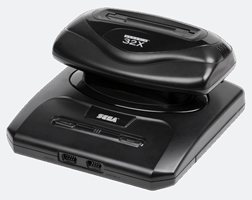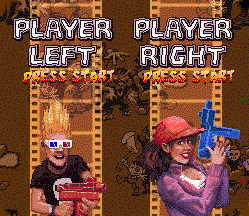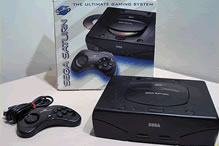Watching Sega of America go through its different stages, from a tiny division with no software development a company that strictly makes software, one tends to think that all the events that befell it came out of the blue. As many who worked  there can attest, this is simply not the case. Even something like the 32X, which was pushed as an inexpensive alternative to the upcoming and much more expensive Saturn, had its future foreseen by those who worked on it.
there can attest, this is simply not the case. Even something like the 32X, which was pushed as an inexpensive alternative to the upcoming and much more expensive Saturn, had its future foreseen by those who worked on it.
One such person is Toshiyasu Morita, a technical director at Sega of America throughout its 16-bit dominance and past the demise of the Dreamcast. He was involved with the 32X and saw its launch, and he was also involved with several Genesis and 32X titles, such as Zombies Ate My Neighbors and Doom. He recently spoke to us about his time at the software giant and his experiences making games.
Sega-16: Before coming to Sega, you were a programmer and technology manager at LucasArts. What prompted the move to the House of Sonic?
Toshiyasu Morita: I went from Manager of New Technology to Technical Director, and there was also a raise.
Sega-16: As a Technical Director at Sega, what new hardware did you get to evaluate? Were there any that never saw release?
Toshiyasu Morita: I evaluated a lot of hardware, mostly PC 3D hardware such as the SMOS Pixelsquirt, Lockheed-Martin Real3D, and processors such as the PowerPC. Was involved in two pieces of hardware which were never released: an SH3E+Nvidia combo which never went anywhere, and I was on the compiler/debugger guy for the SH4+3Dfx board.
Sega-16: Zombies Ate My Neighbors is an excellent cooperative title, and it’s become a fan favorite. Recently, SouthPeak Interactive attempted to recreate its magic with Monster Madness on the Xbox 360 but fell….short, to say the least (to be fair, they’re releasing an improved version for the Playstation 3). What do you think has allowed the game to maintain its popularity and inspire similar efforts?
Toshiyasu Morita: The game is easy to play, because the controls are fairly simple. But, it’s very difficult to master because there are fifty-five levels. While you’re playing, the game is entertaining because the graphics are great, and the music is catchy, and there’s a lot of secret areas to find. So it’s probably still popular because it’s easy to play, hard to master, and entertaining. Probably inspiring similar efforts because people had fun playing it!
Sega-16: You did the cross-platform engine for ZAMN. Were there any particular things that had to be altered or left out for the game to run on the SNES?
 Toshiyasu Morita: ZAMN was designed *for* and developed *on* the SNES, so it has everything. We started a port to the Genesis about halfway through development – we had one guy converting graphics (doh, can’t remember his name) and Mark Haigh-Hutchinson hand-ported the 65816 assembly to 68000 assembly.
Toshiyasu Morita: ZAMN was designed *for* and developed *on* the SNES, so it has everything. We started a port to the Genesis about halfway through development – we had one guy converting graphics (doh, can’t remember his name) and Mark Haigh-Hutchinson hand-ported the 65816 assembly to 68000 assembly.
The same Mike Ebert/Dean Sharpe/Tony Hsieh team did Metal Warriors with the ZAMN game engine, and another internal team did Big Sky Trooper with the same game engine. Also, the ZAMN engine was licensed out to a third party for Ghoul Patrol, which was the sequel to ZAMN.
Sega-16: Doom for the 32X was supposedly rushed in order to make the launch date. What kind of difficulties did you encounter trying to finish it up on time?
Toshiyasu Morita: Doom 32X was supposed to have been a three month port that wound up taking about eight months, I think. I was originally dragged into the project to do the sound driver. After the sound driver was done, I realized the GCC compiler supplied by Hitachi had serious bugs, so I wound up helping Jonathan Flamm find all the bugs. The running joke at the time was that I was an unpaid employee of Cygnus Support (the compiler vendor) because I was spending all of my time on compiler problems.
Sega-16: The 32X has been much-maligned for its sound. Was the hardware truly as bad as it was made out to be, or could it have proven its power if given a chance?
Toshiyasu Morita: The sound hardware wasn’t that bad, in my honest opinion. It acquired a bad reputation due to Doom 32X, and the reason Doom had bad quality sound is because it had a lot of digitized sound on it, and in order to make it fit on a cartridge, we had to use some very lousy compression. I can blame Jesse Taylor for the compression. 🙂
There were some later games which had pretty good sound, such as Tempo and Shadow Squadron, if I remember correctly.
Sega-16: Former SOA president Tom Kalinske told us that the 32X was a “stop-gap measure,” and former Sega Technical Institute graphic artist Chris Senn said it was “a band-aid designed to eventually fall off.” Do you agree with them?
Toshiyasu Morita: Mostly yes. It was originally designed to extend the life of the Genesis, but there was some talk later of a Genesis with a 32X built-in, so people might have changed their mind at some point, though.
The 32X was designed in the US. I was actually in the meeting where Shinobu Toyoda asked us to develop a piece of hardware which would extend the life of the Sega Genesis because the ramp-up of Saturn software sales was expected to be rather slow, probably due to the high cost of the Saturn.
Sega-16: Do you think the Saturn needed to be rushed as it was? Would it have been able to compete with the Playstation had it been held until its original September date?
 Toshiyasu Morita: The main problem with the Saturn, in my opinion, was that it was a weak design. I don’t think waiting a few months would have made any difference. Probably fewer hardware bugs, but the same weak design.
Toshiyasu Morita: The main problem with the Saturn, in my opinion, was that it was a weak design. I don’t think waiting a few months would have made any difference. Probably fewer hardware bugs, but the same weak design.
Sega-16: You arrived at Sega when the company was at its peak and you left after the Dreamcast had been discontinued and focus shifted to creating games for multiple platforms. What was it like seeing such a great hardware company give up making consoles?
Toshiyasu Morita: It really wasn’t a great shock to see Sega giving up hardware. Internally, many of us had been talking about this for at least three or four years before the event happened. My impression was that since Sega started out as a hardware company, most of the senior people in management were hardware people, and therefore they didn’t want to view the company as a software company because it would mean they were no longer relevant.
One very sad thing I see is Sony following directly in Sega’s footsteps. The Playstation hardware is becoming more difficult to program and also more expensive. If this trend continues, Sony may be forced to exit the hardware market eventually also.

Pingback: Os planetas da Sega em nomes de projeto: Saturn, Jupiter, Mars, Neptune... - Memória BIT
Pingback: Entrevista: Michael Hara (executivo ex-Nvidia) - Memória BIT